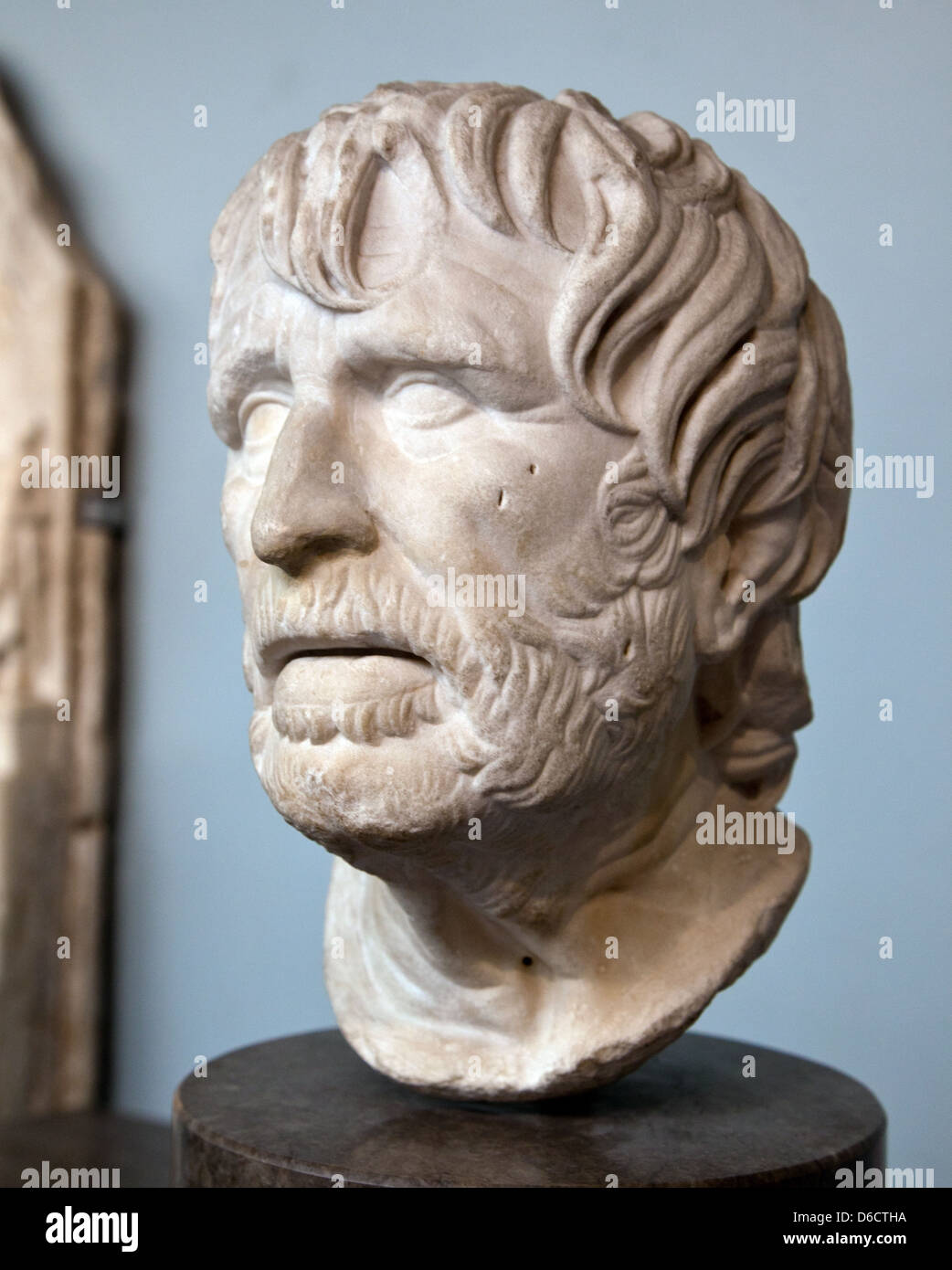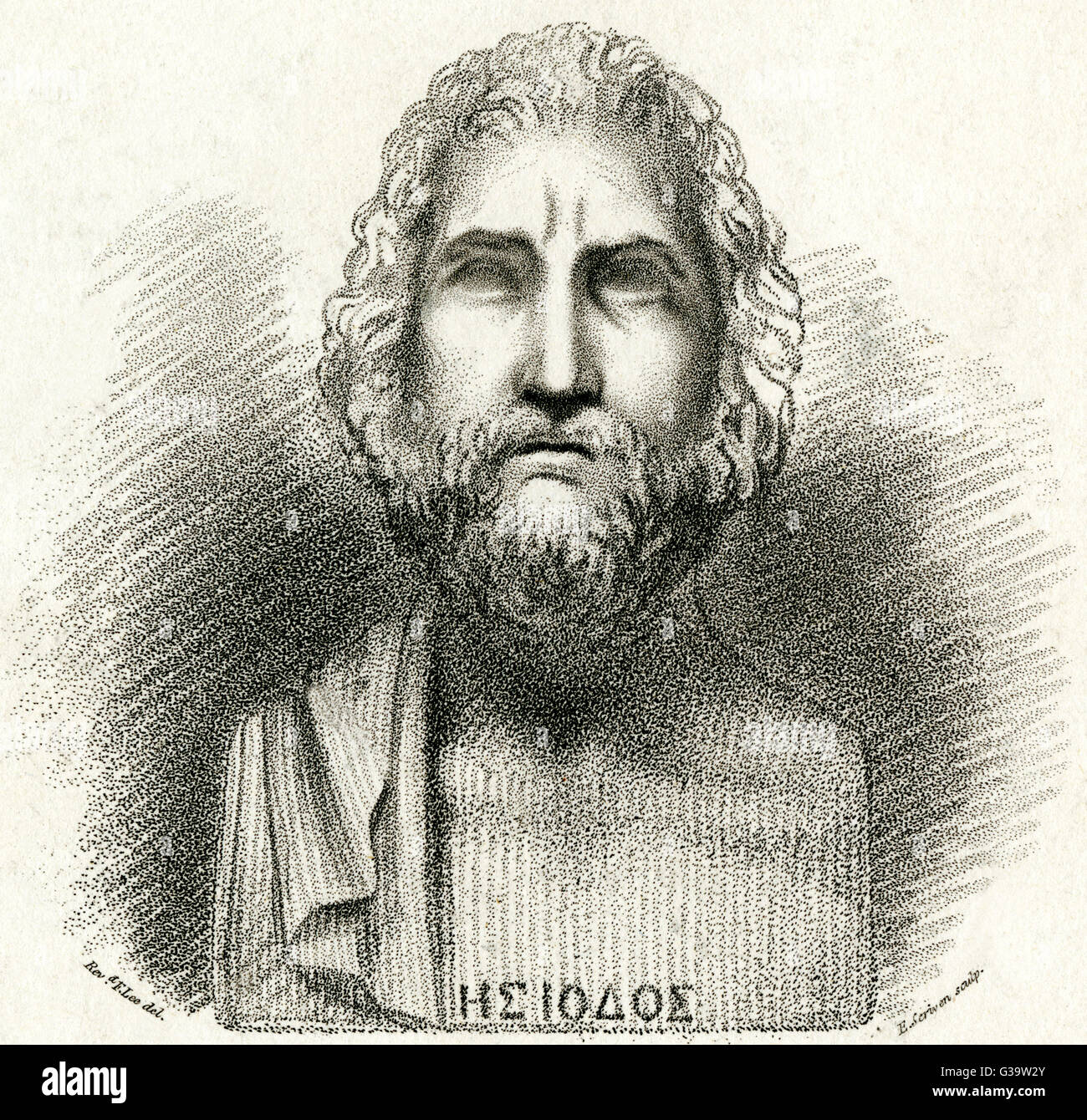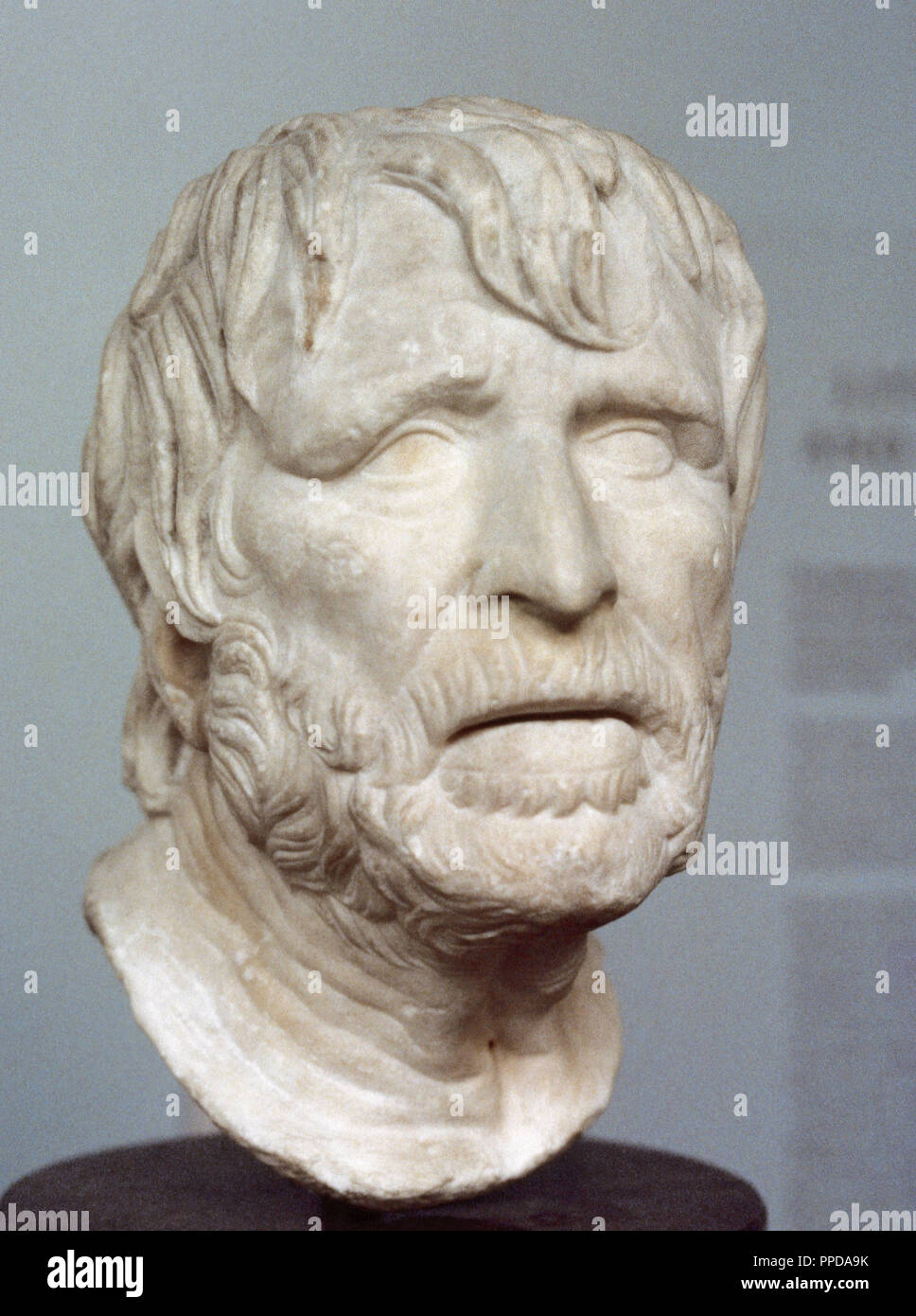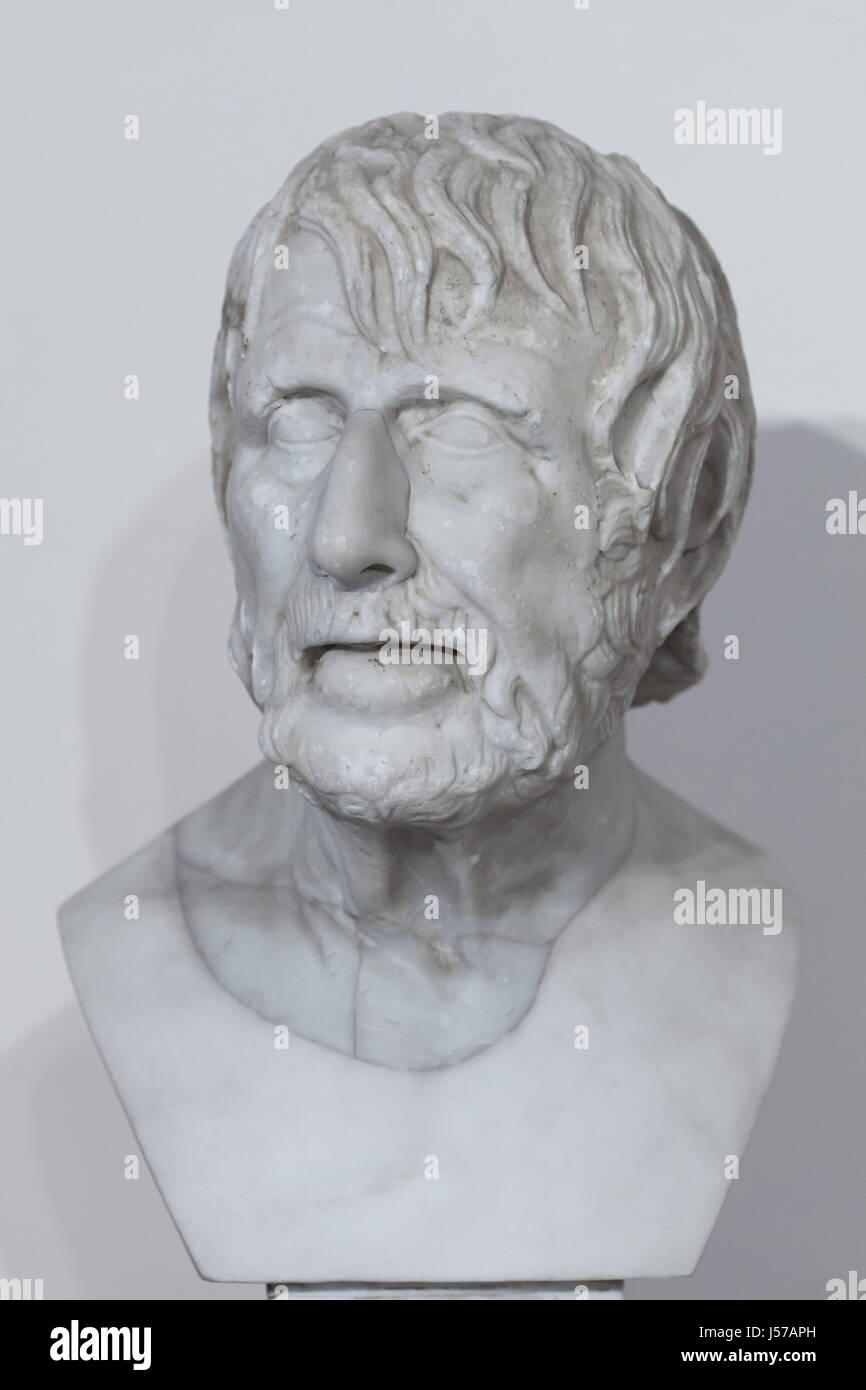Quick filters:
Hesiod bust Stock Photos and Images
 Bust of the Greek poet Hesiod The British Museum London UK Stock Photohttps://www.alamy.com/image-license-details/?v=1https://www.alamy.com/stock-photo-bust-of-the-greek-poet-hesiod-the-british-museum-london-uk-55601766.html
Bust of the Greek poet Hesiod The British Museum London UK Stock Photohttps://www.alamy.com/image-license-details/?v=1https://www.alamy.com/stock-photo-bust-of-the-greek-poet-hesiod-the-british-museum-london-uk-55601766.htmlRMD6CTHA–Bust of the Greek poet Hesiod The British Museum London UK
 Head of Hesiod for Cooke's Translation, Jane Ireland, British, William Hogarth, English, 1697 - 1764, Etching and aquatint on paper, Drawing of a Hesiod bust in side view facing left., England, 1728-1794, Print Stock Photohttps://www.alamy.com/image-license-details/?v=1https://www.alamy.com/head-of-hesiod-for-cookes-translation-jane-ireland-british-william-hogarth-english-1697-1764-etching-and-aquatint-on-paper-drawing-of-a-hesiod-bust-in-side-view-facing-left-england-1728-1794-print-image391090400.html
Head of Hesiod for Cooke's Translation, Jane Ireland, British, William Hogarth, English, 1697 - 1764, Etching and aquatint on paper, Drawing of a Hesiod bust in side view facing left., England, 1728-1794, Print Stock Photohttps://www.alamy.com/image-license-details/?v=1https://www.alamy.com/head-of-hesiod-for-cookes-translation-jane-ireland-british-william-hogarth-english-1697-1764-etching-and-aquatint-on-paper-drawing-of-a-hesiod-bust-in-side-view-facing-left-england-1728-1794-print-image391090400.htmlRM2DM7KP8–Head of Hesiod for Cooke's Translation, Jane Ireland, British, William Hogarth, English, 1697 - 1764, Etching and aquatint on paper, Drawing of a Hesiod bust in side view facing left., England, 1728-1794, Print
 HESIOD Greek poet: portrait bust Date: FL CIRCA 800 BC Stock Photohttps://www.alamy.com/image-license-details/?v=1https://www.alamy.com/stock-photo-hesiod-greek-poet-portrait-bust-date-fl-circa-800-bc-105323427.html
HESIOD Greek poet: portrait bust Date: FL CIRCA 800 BC Stock Photohttps://www.alamy.com/image-license-details/?v=1https://www.alamy.com/stock-photo-hesiod-greek-poet-portrait-bust-date-fl-circa-800-bc-105323427.htmlRMG39W2Y–HESIOD Greek poet: portrait bust Date: FL CIRCA 800 BC
 Pseudo-Seneca. Bust identified with the Roman philosopher Seneca during lot of time. It may represent the Greek poet Hesiod (ca. 700 BC). Roman copy of a lost Hellenistic sculpture. Roman bust. British Museum. London, England. Stock Photohttps://www.alamy.com/image-license-details/?v=1https://www.alamy.com/pseudo-seneca-bust-identified-with-the-roman-philosopher-seneca-during-lot-of-time-it-may-represent-the-greek-poet-hesiod-ca-700-bc-roman-copy-of-a-lost-hellenistic-sculpture-roman-bust-british-museum-london-england-image178577360.html
Pseudo-Seneca. Bust identified with the Roman philosopher Seneca during lot of time. It may represent the Greek poet Hesiod (ca. 700 BC). Roman copy of a lost Hellenistic sculpture. Roman bust. British Museum. London, England. Stock Photohttps://www.alamy.com/image-license-details/?v=1https://www.alamy.com/pseudo-seneca-bust-identified-with-the-roman-philosopher-seneca-during-lot-of-time-it-may-represent-the-greek-poet-hesiod-ca-700-bc-roman-copy-of-a-lost-hellenistic-sculpture-roman-bust-british-museum-london-england-image178577360.htmlRMMAEW6T–Pseudo-Seneca. Bust identified with the Roman philosopher Seneca during lot of time. It may represent the Greek poet Hesiod (ca. 700 BC). Roman copy of a lost Hellenistic sculpture. Roman bust. British Museum. London, England.
 Head of Hesiod for Cookes Translation. Research in ProgressDrawing of a Hesiod bust in side view facing left. Stock Photohttps://www.alamy.com/image-license-details/?v=1https://www.alamy.com/head-of-hesiod-for-cookes-translation-research-in-progressdrawing-of-a-hesiod-bust-in-side-view-facing-left-image359426494.html
Head of Hesiod for Cookes Translation. Research in ProgressDrawing of a Hesiod bust in side view facing left. Stock Photohttps://www.alamy.com/image-license-details/?v=1https://www.alamy.com/head-of-hesiod-for-cookes-translation-research-in-progressdrawing-of-a-hesiod-bust-in-side-view-facing-left-image359426494.htmlRM2BTN84E–Head of Hesiod for Cookes Translation. Research in ProgressDrawing of a Hesiod bust in side view facing left.
 Head of an old man, perhaps, Hesiod ( Greek poet active c. 750-650 BC. )Bust. Roman copy. British Museum. London. United Kingdom. Stock Photohttps://www.alamy.com/image-license-details/?v=1https://www.alamy.com/stock-photo-head-of-an-old-man-perhaps-hesiod-greek-poet-active-c-750-650-bc-bust-143352226.html
Head of an old man, perhaps, Hesiod ( Greek poet active c. 750-650 BC. )Bust. Roman copy. British Museum. London. United Kingdom. Stock Photohttps://www.alamy.com/image-license-details/?v=1https://www.alamy.com/stock-photo-head-of-an-old-man-perhaps-hesiod-greek-poet-active-c-750-650-bc-bust-143352226.htmlRMJ9676A–Head of an old man, perhaps, Hesiod ( Greek poet active c. 750-650 BC. )Bust. Roman copy. British Museum. London. United Kingdom.
 Marble bust of the so-called Pseudo-Seneca. Roman copy from the 1st century AD after a Greek original from the end of the 2nd century BC from the Farnese Collection on display in the National Archaeological Museum in Naples, Campania, Italy. The bust was hoped to be a portrait of Roman Stoic philosopher Seneca the Younger, until the inscribed Roman portrait was identified, now generally identified as an imaginative portrait of either Hesiod or Aristophanes. Stock Photohttps://www.alamy.com/image-license-details/?v=1https://www.alamy.com/stock-photo-marble-bust-of-the-so-called-pseudo-seneca-roman-copy-from-the-1st-140917650.html
Marble bust of the so-called Pseudo-Seneca. Roman copy from the 1st century AD after a Greek original from the end of the 2nd century BC from the Farnese Collection on display in the National Archaeological Museum in Naples, Campania, Italy. The bust was hoped to be a portrait of Roman Stoic philosopher Seneca the Younger, until the inscribed Roman portrait was identified, now generally identified as an imaginative portrait of either Hesiod or Aristophanes. Stock Photohttps://www.alamy.com/image-license-details/?v=1https://www.alamy.com/stock-photo-marble-bust-of-the-so-called-pseudo-seneca-roman-copy-from-the-1st-140917650.htmlRMJ579W6–Marble bust of the so-called Pseudo-Seneca. Roman copy from the 1st century AD after a Greek original from the end of the 2nd century BC from the Farnese Collection on display in the National Archaeological Museum in Naples, Campania, Italy. The bust was hoped to be a portrait of Roman Stoic philosopher Seneca the Younger, until the inscribed Roman portrait was identified, now generally identified as an imaginative portrait of either Hesiod or Aristophanes.
 Marble Bust Of Hesiod The British Museum London UK Stock Photohttps://www.alamy.com/image-license-details/?v=1https://www.alamy.com/stock-photo-marble-bust-of-hesiod-the-british-museum-london-uk-44035714.html
Marble Bust Of Hesiod The British Museum London UK Stock Photohttps://www.alamy.com/image-license-details/?v=1https://www.alamy.com/stock-photo-marble-bust-of-hesiod-the-british-museum-london-uk-44035714.htmlRMCFJ002–Marble Bust Of Hesiod The British Museum London UK
 Hesiod - Thevet - 1584 Stock Photohttps://www.alamy.com/image-license-details/?v=1https://www.alamy.com/stock-photo-hesiod-thevet-1584-56715261.html
Hesiod - Thevet - 1584 Stock Photohttps://www.alamy.com/image-license-details/?v=1https://www.alamy.com/stock-photo-hesiod-thevet-1584-56715261.htmlRMD87GW1–Hesiod - Thevet - 1584
 Portrait, taken from an ancient marble, said to be of Roman philosopher Seneca the Younger. Engraved by Dutch engraver Lucas Vorsterman, 1595-1675, after Peter Paul Rubens, after anonymous. Modern researchers now believe the marble is of Greek poet Hesiod. Stock Photohttps://www.alamy.com/image-license-details/?v=1https://www.alamy.com/portrait-taken-from-an-ancient-marble-said-to-be-of-roman-philosopher-seneca-the-younger-engraved-by-dutch-engraver-lucas-vorsterman-1595-1675-after-peter-paul-rubens-after-anonymous-modern-researchers-now-believe-the-marble-is-of-greek-poet-hesiod-image217620180.html
Portrait, taken from an ancient marble, said to be of Roman philosopher Seneca the Younger. Engraved by Dutch engraver Lucas Vorsterman, 1595-1675, after Peter Paul Rubens, after anonymous. Modern researchers now believe the marble is of Greek poet Hesiod. Stock Photohttps://www.alamy.com/image-license-details/?v=1https://www.alamy.com/portrait-taken-from-an-ancient-marble-said-to-be-of-roman-philosopher-seneca-the-younger-engraved-by-dutch-engraver-lucas-vorsterman-1595-1675-after-peter-paul-rubens-after-anonymous-modern-researchers-now-believe-the-marble-is-of-greek-poet-hesiod-image217620180.htmlRMPJ1CN8–Portrait, taken from an ancient marble, said to be of Roman philosopher Seneca the Younger. Engraved by Dutch engraver Lucas Vorsterman, 1595-1675, after Peter Paul Rubens, after anonymous. Modern researchers now believe the marble is of Greek poet Hesiod.
 HESIOD/HOGARTH/PROFILE Stock Photohttps://www.alamy.com/image-license-details/?v=1https://www.alamy.com/stock-photo-hesiodhogarthprofile-105323426.html
HESIOD/HOGARTH/PROFILE Stock Photohttps://www.alamy.com/image-license-details/?v=1https://www.alamy.com/stock-photo-hesiodhogarthprofile-105323426.htmlRMG39W2X–HESIOD/HOGARTH/PROFILE
 Pseudo-Seneca. Bust identified with the Roman philosopher Seneca during lot of time. It may represent the Greek poet Hesiod (ca. 700 BC). Roman copy of a lost Hellenistic sculpture. Roman bust. British Museum. London, England. Stock Photohttps://www.alamy.com/image-license-details/?v=1https://www.alamy.com/pseudo-seneca-bust-identified-with-the-roman-philosopher-seneca-during-lot-of-time-it-may-represent-the-greek-poet-hesiod-ca-700-bc-roman-copy-of-a-lost-hellenistic-sculpture-roman-bust-british-museum-london-england-image220340335.html
Pseudo-Seneca. Bust identified with the Roman philosopher Seneca during lot of time. It may represent the Greek poet Hesiod (ca. 700 BC). Roman copy of a lost Hellenistic sculpture. Roman bust. British Museum. London, England. Stock Photohttps://www.alamy.com/image-license-details/?v=1https://www.alamy.com/pseudo-seneca-bust-identified-with-the-roman-philosopher-seneca-during-lot-of-time-it-may-represent-the-greek-poet-hesiod-ca-700-bc-roman-copy-of-a-lost-hellenistic-sculpture-roman-bust-british-museum-london-england-image220340335.htmlRMPPDA9K–Pseudo-Seneca. Bust identified with the Roman philosopher Seneca during lot of time. It may represent the Greek poet Hesiod (ca. 700 BC). Roman copy of a lost Hellenistic sculpture. Roman bust. British Museum. London, England.
 Pseudo-Seneca, Portrait of Hesiod (8th century BC)? Unknown Bust Pseudo-Seneca, portræt af Hesiod (8. årh. f.Kr.)? Stock Photohttps://www.alamy.com/image-license-details/?v=1https://www.alamy.com/pseudo-seneca-portrait-of-hesiod-8th-century-bc-unknown-bust-pseudo-seneca-portrt-af-hesiod-8-rh-fkr-image613397060.html
Pseudo-Seneca, Portrait of Hesiod (8th century BC)? Unknown Bust Pseudo-Seneca, portræt af Hesiod (8. årh. f.Kr.)? Stock Photohttps://www.alamy.com/image-license-details/?v=1https://www.alamy.com/pseudo-seneca-portrait-of-hesiod-8th-century-bc-unknown-bust-pseudo-seneca-portrt-af-hesiod-8-rh-fkr-image613397060.htmlRM2XHXJ5T–Pseudo-Seneca, Portrait of Hesiod (8th century BC)? Unknown Bust Pseudo-Seneca, portræt af Hesiod (8. årh. f.Kr.)?
 Head of an old man, perhaps, Hesiod ( Greek poet active c. 750-650 BC. )Bust. Roman copy. British Museum. London. United Kingdom. Stock Photohttps://www.alamy.com/image-license-details/?v=1https://www.alamy.com/stock-photo-head-of-an-old-man-perhaps-hesiod-greek-poet-active-c-750-650-bc-bust-143352266.html
Head of an old man, perhaps, Hesiod ( Greek poet active c. 750-650 BC. )Bust. Roman copy. British Museum. London. United Kingdom. Stock Photohttps://www.alamy.com/image-license-details/?v=1https://www.alamy.com/stock-photo-head-of-an-old-man-perhaps-hesiod-greek-poet-active-c-750-650-bc-bust-143352266.htmlRMJ9677P–Head of an old man, perhaps, Hesiod ( Greek poet active c. 750-650 BC. )Bust. Roman copy. British Museum. London. United Kingdom.
 Marble bust of the so-called Pseudo-Seneca. Roman copy from the 1st century AD after a Greek original from the end of the 2nd century BC from the Farnese Collection on display in the National Archaeological Museum in Naples, Campania, Italy. The bust was hoped to be a portrait of Roman Stoic philosopher Seneca the Younger, until the inscribed Roman portrait was identified, now generally identified as an imaginative portrait of either Hesiod or Aristophanes. Stock Photohttps://www.alamy.com/image-license-details/?v=1https://www.alamy.com/stock-photo-marble-bust-of-the-so-called-pseudo-seneca-roman-copy-from-the-1st-140918361.html
Marble bust of the so-called Pseudo-Seneca. Roman copy from the 1st century AD after a Greek original from the end of the 2nd century BC from the Farnese Collection on display in the National Archaeological Museum in Naples, Campania, Italy. The bust was hoped to be a portrait of Roman Stoic philosopher Seneca the Younger, until the inscribed Roman portrait was identified, now generally identified as an imaginative portrait of either Hesiod or Aristophanes. Stock Photohttps://www.alamy.com/image-license-details/?v=1https://www.alamy.com/stock-photo-marble-bust-of-the-so-called-pseudo-seneca-roman-copy-from-the-1st-140918361.htmlRMJ57APH–Marble bust of the so-called Pseudo-Seneca. Roman copy from the 1st century AD after a Greek original from the end of the 2nd century BC from the Farnese Collection on display in the National Archaeological Museum in Naples, Campania, Italy. The bust was hoped to be a portrait of Roman Stoic philosopher Seneca the Younger, until the inscribed Roman portrait was identified, now generally identified as an imaginative portrait of either Hesiod or Aristophanes.
 Marble bust of the so-called Pseudo-Seneca. Roman copy from the 1st century AD after a Greek original from the end of the 2nd century BC from the Farnese Collection on display in the National Archaeological Museum in Naples, Campania, Italy. The bust was hoped to be a portrait of Roman Stoic philosopher Seneca the Younger, until the inscribed Roman portrait was identified, now generally identified as an imaginative portrait of either Hesiod or Aristophanes. Stock Photohttps://www.alamy.com/image-license-details/?v=1https://www.alamy.com/stock-photo-marble-bust-of-the-so-called-pseudo-seneca-roman-copy-from-the-1st-140918093.html
Marble bust of the so-called Pseudo-Seneca. Roman copy from the 1st century AD after a Greek original from the end of the 2nd century BC from the Farnese Collection on display in the National Archaeological Museum in Naples, Campania, Italy. The bust was hoped to be a portrait of Roman Stoic philosopher Seneca the Younger, until the inscribed Roman portrait was identified, now generally identified as an imaginative portrait of either Hesiod or Aristophanes. Stock Photohttps://www.alamy.com/image-license-details/?v=1https://www.alamy.com/stock-photo-marble-bust-of-the-so-called-pseudo-seneca-roman-copy-from-the-1st-140918093.htmlRMJ57AD1–Marble bust of the so-called Pseudo-Seneca. Roman copy from the 1st century AD after a Greek original from the end of the 2nd century BC from the Farnese Collection on display in the National Archaeological Museum in Naples, Campania, Italy. The bust was hoped to be a portrait of Roman Stoic philosopher Seneca the Younger, until the inscribed Roman portrait was identified, now generally identified as an imaginative portrait of either Hesiod or Aristophanes.
 Head of an old man, perhaps, Hesiod ( Greek poet active c. 750-650 BC. )Bust. Roman copy. British Museum. London. United Kingdom. Stock Photohttps://www.alamy.com/image-license-details/?v=1https://www.alamy.com/stock-photo-head-of-an-old-man-perhaps-hesiod-greek-poet-active-c-750-650-bc-bust-143352184.html
Head of an old man, perhaps, Hesiod ( Greek poet active c. 750-650 BC. )Bust. Roman copy. British Museum. London. United Kingdom. Stock Photohttps://www.alamy.com/image-license-details/?v=1https://www.alamy.com/stock-photo-head-of-an-old-man-perhaps-hesiod-greek-poet-active-c-750-650-bc-bust-143352184.htmlRMJ9674T–Head of an old man, perhaps, Hesiod ( Greek poet active c. 750-650 BC. )Bust. Roman copy. British Museum. London. United Kingdom.
 Marble bust of the so-called Pseudo-Seneca. Roman copy from the 1st century AD after a Greek original from the end of the 2nd century BC from the Farnese Collection on display in the National Archaeological Museum in Naples, Campania, Italy. The bust was hoped to be a portrait of Roman Stoic philosopher Seneca the Younger, until the inscribed Roman portrait was identified, now generally identified as an imaginative portrait of either Hesiod or Aristophanes. Stock Photohttps://www.alamy.com/image-license-details/?v=1https://www.alamy.com/stock-photo-marble-bust-of-the-so-called-pseudo-seneca-roman-copy-from-the-1st-140917974.html
Marble bust of the so-called Pseudo-Seneca. Roman copy from the 1st century AD after a Greek original from the end of the 2nd century BC from the Farnese Collection on display in the National Archaeological Museum in Naples, Campania, Italy. The bust was hoped to be a portrait of Roman Stoic philosopher Seneca the Younger, until the inscribed Roman portrait was identified, now generally identified as an imaginative portrait of either Hesiod or Aristophanes. Stock Photohttps://www.alamy.com/image-license-details/?v=1https://www.alamy.com/stock-photo-marble-bust-of-the-so-called-pseudo-seneca-roman-copy-from-the-1st-140917974.htmlRMJ57A8P–Marble bust of the so-called Pseudo-Seneca. Roman copy from the 1st century AD after a Greek original from the end of the 2nd century BC from the Farnese Collection on display in the National Archaeological Museum in Naples, Campania, Italy. The bust was hoped to be a portrait of Roman Stoic philosopher Seneca the Younger, until the inscribed Roman portrait was identified, now generally identified as an imaginative portrait of either Hesiod or Aristophanes.
 Marble bust of the so-called Pseudo-Seneca. Roman copy from the 1st century AD after a Greek original from the end of the 2nd century BC from the Farnese Collection on display in the National Archaeological Museum in Naples, Campania, Italy. The bust was hoped to be a portrait of Roman Stoic philosopher Seneca the Younger, until the inscribed Roman portrait was identified, now generally identified as an imaginative portrait of either Hesiod or Aristophanes. Stock Photohttps://www.alamy.com/image-license-details/?v=1https://www.alamy.com/stock-photo-marble-bust-of-the-so-called-pseudo-seneca-roman-copy-from-the-1st-140917786.html
Marble bust of the so-called Pseudo-Seneca. Roman copy from the 1st century AD after a Greek original from the end of the 2nd century BC from the Farnese Collection on display in the National Archaeological Museum in Naples, Campania, Italy. The bust was hoped to be a portrait of Roman Stoic philosopher Seneca the Younger, until the inscribed Roman portrait was identified, now generally identified as an imaginative portrait of either Hesiod or Aristophanes. Stock Photohttps://www.alamy.com/image-license-details/?v=1https://www.alamy.com/stock-photo-marble-bust-of-the-so-called-pseudo-seneca-roman-copy-from-the-1st-140917786.htmlRMJ57A22–Marble bust of the so-called Pseudo-Seneca. Roman copy from the 1st century AD after a Greek original from the end of the 2nd century BC from the Farnese Collection on display in the National Archaeological Museum in Naples, Campania, Italy. The bust was hoped to be a portrait of Roman Stoic philosopher Seneca the Younger, until the inscribed Roman portrait was identified, now generally identified as an imaginative portrait of either Hesiod or Aristophanes.
 Bronze bust of the so-called Pseudo-Seneca. Roman copy from the 1st century AD after a Greek original from the end of the 2nd century BC found in the rectangular peristyle in the Villa dei Papiri (Villa of the Papyri) in Herculaneum on display in the National Archaeological Museum in Naples, Campania, Italy. The bust was hoped to be a portrait of Roman Stoic philosopher Seneca the Younger, until the inscribed Roman portrait was identified, now generally identified as an imaginative portrait of either Hesiod or Aristophanes. Stock Photohttps://www.alamy.com/image-license-details/?v=1https://www.alamy.com/stock-photo-bronze-bust-of-the-so-called-pseudo-seneca-roman-copy-from-the-1st-140918085.html
Bronze bust of the so-called Pseudo-Seneca. Roman copy from the 1st century AD after a Greek original from the end of the 2nd century BC found in the rectangular peristyle in the Villa dei Papiri (Villa of the Papyri) in Herculaneum on display in the National Archaeological Museum in Naples, Campania, Italy. The bust was hoped to be a portrait of Roman Stoic philosopher Seneca the Younger, until the inscribed Roman portrait was identified, now generally identified as an imaginative portrait of either Hesiod or Aristophanes. Stock Photohttps://www.alamy.com/image-license-details/?v=1https://www.alamy.com/stock-photo-bronze-bust-of-the-so-called-pseudo-seneca-roman-copy-from-the-1st-140918085.htmlRMJ57ACN–Bronze bust of the so-called Pseudo-Seneca. Roman copy from the 1st century AD after a Greek original from the end of the 2nd century BC found in the rectangular peristyle in the Villa dei Papiri (Villa of the Papyri) in Herculaneum on display in the National Archaeological Museum in Naples, Campania, Italy. The bust was hoped to be a portrait of Roman Stoic philosopher Seneca the Younger, until the inscribed Roman portrait was identified, now generally identified as an imaginative portrait of either Hesiod or Aristophanes.